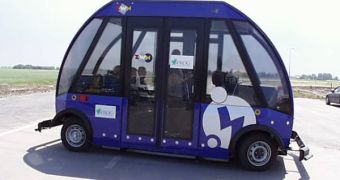European researchers have recently developed a new type of control system that will in the near future allow driver-less cybercars to take over the streets. Fleets of high throughput rapid transit systems could become the most common means of transportation, all components working without flaw and in perfect cooperation with each other. Accidents caused by careless drivers could thus become a thing of the past. The secret is to allow the cars to “speak” to each other, the researchers say, quoted by ICT Results.
Already, a large number of transport vehicles perform the job of getting people to their workplaces everyday flawlessly. But their autonomy is severely restricted, and humans still have to be kept in the loop. Experts from the European team that conducted the CyberCars2 project say that the key to creating the most efficient independent transport system is to allow for its components to communicate among themselves, so as to decide the best course of action in common.
This could translate into less or no traffic jams, as cybercars would be able to efficiently work their way around them, or prevent them from ever happening. Because the entire system will be in constant communication, its users would be safe from accidents caused by people who cannot read traffic signs, or who are too tired to drive, and yet do so. The new, driver-less vehicles would take over those tasks, and would adjust their speeds in such a manner that they would get the passengers to their destination in the shortest time, at the same time respecting the most basic safety demands.
“The software developed by the predecessor CyberCars project was for moving vehicles independently at fairly large distances. We used the same block system as railways, where a vehicle cannot proceed until the one in front has cleared a section,” explains the CyberCars2 project coordinator Michel Parent, from the Institut National de Recherche en Informatique et Automatique (INRIA), in France.
“But block technology only allows a low throughput. The communication and decision-making modules we have developed help to increase the efficiency of an automated service through coordination which will adjust the speed of vehicles as they approach junctions so they can cross without having to stop,” he concludes.

 14 DAY TRIAL //
14 DAY TRIAL //